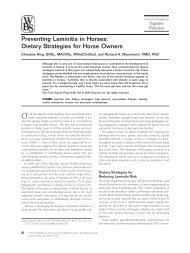Nutritional Secondary Hyperparathyroidism in the Horse
Nutritional Secondary Hyperparathyroidism in the Horse
Nutritional Secondary Hyperparathyroidism in the Horse
You also want an ePaper? Increase the reach of your titles
YUMPU automatically turns print PDFs into web optimized ePapers that Google loves.
42 Experimental <strong>Nutritional</strong> <strong>Secondary</strong> <strong>Hyperparathyroidism</strong> <strong>in</strong> <strong>the</strong> <strong>Horse</strong>. . .<br />
4. Cl<strong>in</strong>ico-pathologic Determ<strong>in</strong>ations<br />
A 50-cc. sample of blood was taken from ei<strong>the</strong>r jugular ve<strong>in</strong> prior<br />
to <strong>the</strong> afternoon feed<strong>in</strong>g 1 day a week. Calcium, phosphorus, and<br />
alkal<strong>in</strong>e phosphatase levels <strong>in</strong> <strong>the</strong> serum were measured. The calcium<br />
level was determ<strong>in</strong>ed accord<strong>in</strong>g to <strong>the</strong> method of KRAMER and TISDALL<br />
(1921) as modified by CLARK and COLLIP (1925); <strong>the</strong> phosphorus<br />
accord<strong>in</strong>g to FISKE and SUBBAROW (1925), and <strong>the</strong> phosphatase by <strong>the</strong><br />
method of BESSEY et al. (1946).<br />
5. Roentgenologic Exam<strong>in</strong>ation<br />
Intravitul exam<strong>in</strong>ations. Radiographs were takenat2-week <strong>in</strong>tervals.<br />
To control motion <strong>the</strong> animals were tranquilized (by 200 mg. of<br />
promaz<strong>in</strong>e HC1 <strong>in</strong>travenously) and placed on an operat<strong>in</strong>g table <strong>in</strong><br />
right lateral recumbency. A lateral view of <strong>the</strong> face was taken, <strong>in</strong>clud<strong>in</strong>g<br />
all tissues rostral to <strong>the</strong> fourth premolar. A lateral view of <strong>the</strong><br />
metatarsus was also taken. A lack of uniformity <strong>in</strong> <strong>the</strong> technique and<br />
an excessive amount of tissue made lateral views of <strong>the</strong> face difficult to<br />
<strong>in</strong>terpret. At week 26 and every 2 weeks <strong>the</strong>reafter a ventrodorsal<br />
view of <strong>the</strong> mandible was taken by plac<strong>in</strong>g a nonscreen film envelope<br />
<strong>in</strong> <strong>the</strong> animal's mouth. Because of a m<strong>in</strong>imum of soft tissue and no<br />
superimposition of bones, <strong>the</strong>se views of <strong>the</strong> rostral end of <strong>the</strong><br />
mandible were superior to views of <strong>the</strong> entire face.<br />
Roentgenographic exam<strong>in</strong>ation of post-mortem specimens. At necropsy<br />
<strong>the</strong> soft tissue was removed from <strong>the</strong> bones and radographs were<br />
made prior to fixation for section<strong>in</strong>g. The radiographs were as follows :<br />
a) Lateral view of a median longitud<strong>in</strong>al section, approximately<br />
1 cm. thick, from all bones of both right limbs;<br />
b) Proximodistal view of a transverse section, approximately<br />
1 cm. thick, from <strong>the</strong> proximal, middle, and distal part of <strong>the</strong> diaphysis<br />
of all bones of both left limbs;<br />
c) Lateral view of each half of <strong>the</strong> head split midsagitally;<br />
d) Anteroposterior view of a transverse section of <strong>the</strong> maxilla,<br />
approximately 1 cm. thick, at <strong>the</strong> level of <strong>the</strong> second molar;<br />
e) Ventrodorsal view of <strong>the</strong> rostral third of <strong>the</strong> mandible;<br />
f) Lateral view of each half of <strong>the</strong> mandible split through <strong>the</strong><br />
symphysis ;<br />
g) Anteroposterior and lateral views of right ribs 3 and 10.<br />
Downloaded from<br />
vet.sagepub.com by guest on April 14, 2010



